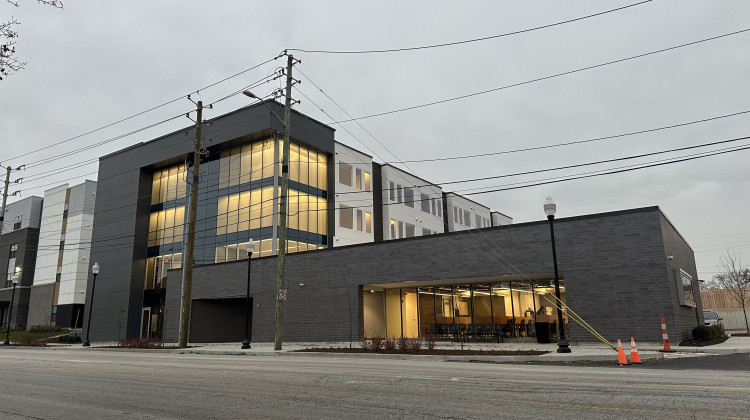
Compass on Washington is one of the city’s latest efforts in its plan to make homelessness rare, short-lived and recoverable.
Zak Cassel / WFYIRestee Johnson knows the streets. He said he was homeless for over twenty years. More recently, he’s worked in harm reduction and street outreach to help people experiencing homelessness in Indianapolis.
“There is no dignity in being homeless. It was a lonely, dark place where I felt disconnected, depressed, alienated from society. The degradation and the traumatic experiences of being homeless had an impact on me — spiritually, physically, and especially mentally,” Johnson said.
He’s a supporter of a model to reduce homelessness called “housing first,” the idea that the solution to homelessness is housing people first without barriers — but with support, so they’re able to work on other chronic issues.
In Johnson’s struggle to find housing, he navigated a criminal record, drugs and alcohol, depression, and serious health issues. He finally qualified for a furnished apartment in a senior living complex that provided services such as a trained recovery coach. He said it gave him “a hand up.”
“My relationships with family and the community are stronger. I reconnected with my son and grandkids. My apartment is full of new furniture. I have a strong, positive support group. My faith and passion has been rekindled, giving me a new perspective on life,” he said.
Johnson shared his story last November with over a hundred people gathered for a ribbon-cutting ceremony at a new housing complex on the near east side. Compass on Washington is a 36-unit complex that provides permanent supportive housing for seniors experiencing chronic homelessness in partnership with Horizon House, a local nonprofit that works with people experiencing homelessness.
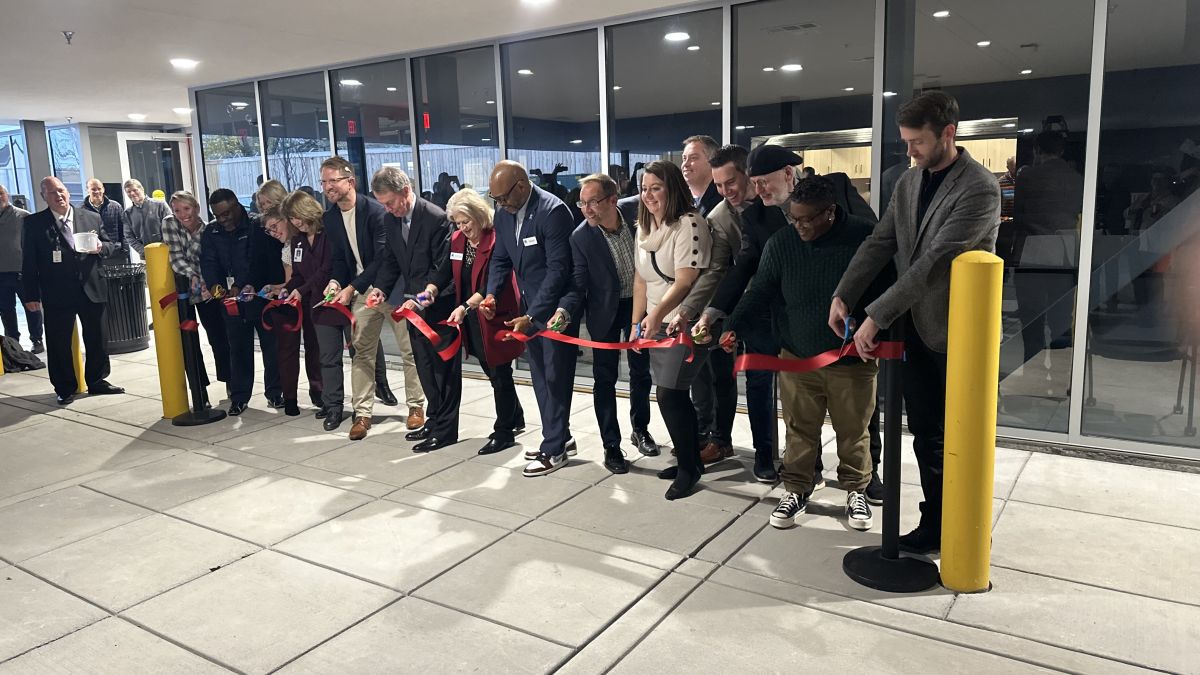
Horizon House is primarily a day center that offers short and long term supportive services. The services have a wide, multidisciplinary range, including basic needs, healthcare, mental health and recovery support, legal assistance, independent living skills, and community integration.
The nonprofit piloted permanent supportive housing projects in 2020 and currently has 120 scattered site units in partnership with the city. Now Horizon House will be able to provide those services to the residents of Compass on Washington right next door.
“If you’ve got a mental health issue, a medical issue, a substance use issue, to try and work on that while you’re living out on the streets… it’s difficult, if not impossible,” said Teresa Wessel, the former CEO of Horizon House. “If we can solve that housing crisis, you don’t have to be clean and sober, right? The idea is to move you in, solve that housing crisis, and then work with you on all those barriers at your own rate and pace.”
Before retiring at the end of last year, Wessel ran Horizon House for 14 years and oversaw the development of Compass on Washington.
Compass is the ninth permanent supportive housing project the city has opened since 2019, according to data from September 2024 that WFYI obtained from the Indianapolis Department of Metropolitan Development. With Compass and another Horizon project, the city’s total permanent, supportive housing units have increased by 328 since 2019.
The most recent annual census of people experiencing homelessness in Indianapolis found 1,701 on a single night in January 2024, which is a slight increase from the previous year. Racial inequities persist in homelessness data. More than half of those surveyed in last year’s census were Black, compared with 30 percent in the county. Indianapolis has also seen an increase in families experiencing homelessness.
Despite success with supportive housing projects that bring people out of homelessness and provide a safe place to work through issues, Indianapolis fell short of an ambitious goal set by stakeholders six years ago.
The Indianapolis Community Plan to End Homelessness
In 2018 community leaders — including the city, clergy, nonprofits, and others — came together to work on a plan to end the homelessness crisis in Indianapolis.
“By 2023, any individual or family in Indianapolis who becomes homeless will spend no more than 30 days without a permanent, safe, affordable place to live. No one who loses their job or experiences domestic violence will have to choose between the safety of themselves and their children and having a secure place to stay. No one will be released from a hospital, the criminal justice system, or the foster care system without a place to call home,” the plan read.
The planning process incorporated many community voices through activities like listening sessions, interviews, surveys, community-wide and population-specific planning sessions, and public comment.
“More than 400 individuals representing 82 unique organizations, at least 170 of whom are experiencing or have experienced homelessness first-hand, provided their leadership and expertise throughout the planning process,” it read.
Under the plan, these groups would coordinate on different aspects in order to achieve strategic priorities aimed at reducing the time people experience homelessness. Those include expanding wraparound services, coordinating different institutions so people aren’t released into homelessness, and more efficiently distributing resources.
The plan also aimed to significantly increase the city’s supportive housing stock by 222 units of permanent supportive housing per year from 2019 to 2023 — for a total of 1,110 units. That hasn’t happened.
What’s holding Indianapolis back?
Stakeholders said there are many obstacles that have impacted the implementation of the 2018 plan.
Rodney Stockment is a city’s policy director of homelessness at DMD.
“Frankly, when the plan was developed — the [222 units] a year — it was kind of not based on a lot of factual mapping,” he said. “We’re doing an investment mapping project now where we have numbers more precise.”
He said that many of these projects rely on a complicated funding stream administered through the state called the Low Income Housing Tax Credit Program, which has made financing units difficult.
“Basically, it’s just been a tough environment to do development,” he said.
So far, the city has received and committed $15.3 million on the Housing to Recovery fund, which pays for the housing project costs. The city itself has contributed the largest amount of money to the fund — $4 million — with the rest of the support coming from a mix of foundations and private companies.
Chelsea Haring-Cozzi is executive director of the Indianapolis Coalition for Homelessness Intervention and Prevention, or CHIP. She said that projects like these involve complicated logistics and multiple parties coming together to bring brick and mortar solutions into existence.
She said the pandemic had perhaps the greatest impact, as costs rose significantly.
“Supply chain issues created lots of delays in building and the construction process. It has taken a lot of time to develop new projects,” she said.
The federal government pumped massive amounts of funding into different sectors of the economy in an effort to prevent an economic downturn. Municipalities, nonprofits, and other community organizations qualified for initial funding to address the pandemic-related needs of the country’s homeless. In Indianapolis, federal relief funding was used initially to house individuals experiencing homelessness in hotel rooms in order to prevent transmission of the virus.
The 2021 American Rescue Plan infused a third round of funding into a U.S. Department of Housing and Urban Development program designed to create affordable housing for low income individuals. This $5 billion financial windfall could be used by eligible organizations to provide housing, rental assistance, and supportive services.
Stockment said that the city spent $7.5 million of its nearly $15 million funding allocation on permanent supportive housing units.
The city’s HOME-ARP Allocation Plan submitted to the U.S. Department of Housing and Urban Development in June 2022 stated that the largest gap in provision of permanent housing options was funding for supportive services. Each person brought into the system of care was estimated in the allocation plan to need about $6,000 of supportive services in order to recover from homelessness.
“Affordable housing projects traditionally take years of planning, including finding the necessary financial capital to begin development,” it said.
It proposed creating 130 units of permanent affordable, supportive housing units. In reality, the money has been committed to build King Commons, a projected 34-unit project that the city anticipates will open for residents this summer.
The future of supportive housing
The one-bedroom, 515 square-foot units in Compass on Washington come completely furnished. A small entryway gives way to a full-use kitchen with brand new appliances — including a dishwasher. The unit has modest furniture, including tables, a sofa, and a chair. These units are on the west side of the building, so the large windows provide a full view of downtown Indianapolis from across the highway.
Downstairs, there are some common rooms. Horizon House will provide supportive services to residents including basic needs, health care, mental health and recovery support, legal assistance, and community integration.
At the ribbon cutting event last year, the housing community was abuzz with excitement. Leaders at Horizon House, Englewood Community Development, the property manager and the city— said they’ve been waiting a long time for this moment.
There’s local evidence that shows permanent supportive housing works. Leaders at DMD, CHIP, and Horizon House all said retention rates are higher than the national average — above 90 percent. Broader research has also found that permanent supportive housing can create successful outcomes for the unhoused, according to a research brief from Indiana University’s Public Policy Institute.
But CHIP’s Haring-Cozzi said that there is still a large gap in the system: Indianapolis needs a fully-functioning housing agency. The Indianapolis Housing Agency has recently entered a cooperative agreement between HUD and the city after years of mismanagement and dysfunction.
“It’s essentially in a recovery process,” said Haring-Cozzi.
CHIP receives about 30 housing vouchers per month, which covers rent for eligible individuals. Haring-Cozzi said they need more housing vouchers and a quicker turnaround time for an individual to be approved.
“Vouchers are one of the most valuable housing resources out there, in terms of making up that gap between income and rent prices and really getting people out of homelessness into permanent housing,” said Haring-Cozzi.
Stockment, of the city’s Department of Metropolitan Development, also agreed that Indianapolis needs to get people housed quicker.
“It takes people like 90 days’ time to get a voucher to get housed, and we need to cut that time period down,” he said.
The city said scaling up programs to meet the need has been difficult.
“You have inflow into the system of people becoming homelessness, and you're slowing down the number of people you house,” said Stockment. “We really want to figure out how to get people housed quicker, where the inflow matches the outflow. The number of people becoming homeless matches the number of new units being brought online.”
Despite the money already raised, stakeholders also agreed that there’s a need for private investment. DMD estimated it still needs $26.5 million to fund both new and legacy projects through 2029.
That’s where a new master leasing program comes in. The city is currently building partnerships with landlords to create five year leases for people to be housed in, in addition to building new complexes. The idea is that it will increase available units while providing protections for renters that might otherwise not be approved by a traditional landlord. It’s considered a form of permanent, supportive housing.
“This is a very landlord-friendly state,” said Stockment. “A lot of people experiencing homelessness have had various challenges with their rental history, and those challenges keep people from being housed, and so master leasing kind of side steps that issue.”
But the master leasing program is only supplementing the city’s current permanent supportive housing project plans. Those are still in progress.
Because of the challenges the city faced in implementing the original 2018 Plan to End Homelessness, it’s modifying it.
CHIP is working with two consultants, said Haring-Cozzi — a developer of a modeling tool and the “architect behind Houston’s strategy and huge reduction in homelessness.”
The new system aims to have more precise numbers that will allow the city to estimate how many units it needs to reduce homelessness and how much that will cost.
Stockment said a revised plan to end homelessness should be finalized within a couple months time.
The annual count of people experiencing homelessness in Indianapolis is scheduled for later this month.
Contact data journalist Zak Cassel at zcassel@wfyi.org.
 DONATE
DONATE



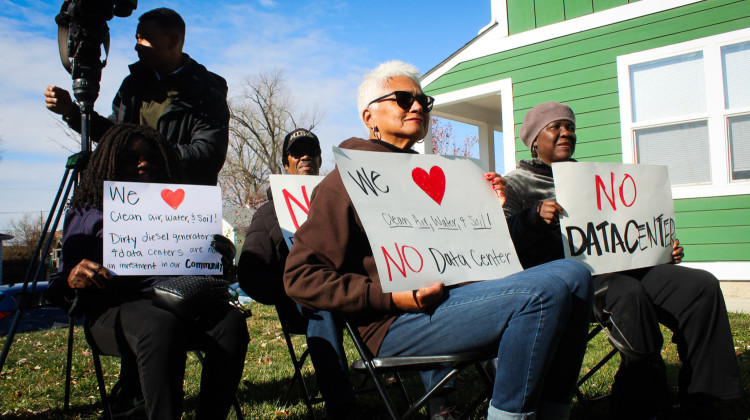
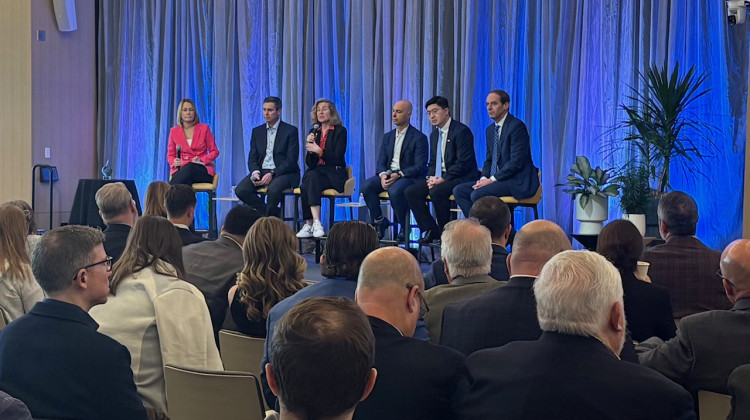
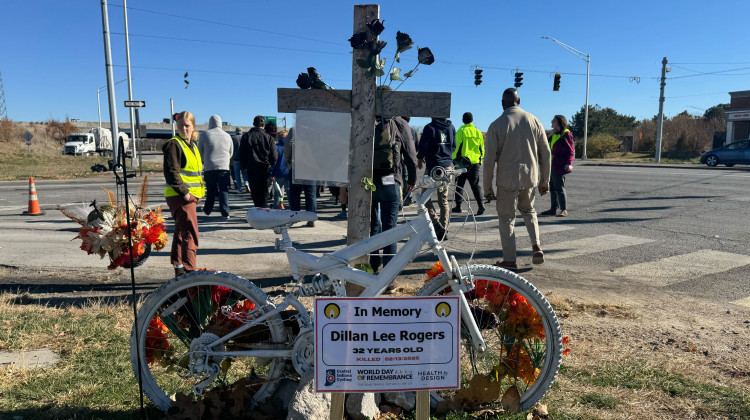

 Support WFYI. We can't do it without you.
Support WFYI. We can't do it without you.